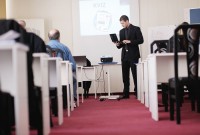- Home
- Business Processes
- Industry Knowledge
- Aerospace Industry
- Automotive Industry
- Banking Domain
- BFSI Industry
- Consumer/ FMCG Industry
- Chemicals Industry
- Engineering & Construction
- Energy Industry
- Education Domain
- Finance Domain
- Hospitality Domain
- Healthcare Industry
- Insurance Domain
- Retail Industry
- Travel and Tourism Domain
- Telecom Industry
- Leadership Skills
- eLearning
- Home
- Leadership
- Change Management
- Contingency Theories in Action
Contingency Theories in Action
Contingency theory suggests matching the best leader to a specific situation based on situational factors and the leadership style. The practical application of theory can be done in various ways. The workplace example is to determine the best candidate for a given set of requirements using the LPC score. Applying the model to determine a leader's ability to adapt in the scenario of a new project etc..
Recap of Learnings from Contingency Theory:
Fielder’s contingency theory matches the leader to the situations by using the Least Preferred Co-Worker (LPC) model. A leader can perform effectively in certain roles and exhibit weakness in different situations based on three variables defined in the earlier article which predicts the favorability of the situation, while the leader’s LPC score determines the ability to function in the required task.
One can make use of the contingency theory to determine the best candidate for a given set of job requirements for effectiveness of a person in that role as by measuring a leader’s LPC score and the three situational variables, one can predict whether the leader is going to be effective in a particular setting. By assessing these three situational variables, one can place any organizational context in one of the eight categories represented in previous article. Once the nature of the situation is determined, the fit between the leader’s style and the situation can be evaluated.
Key Strengths of Contingency Theory:
1. Contingency theory is grounded in research as many researchers have tested it and found it to be a valid and reliable approach to explaining how effective leadership can be achieved.
2. This theory considers the impact of situations on leaders and focuses on the relationship between the leader’s style and the demands of various situations.
3. Third, contingency theory has predictive power and based on conclusions from LPC scale and understanding the context of the workplace situation one can determine the probability of success for a given person in a given situation.
4. From an organizational perspective it supports identification of optimal roles based on individual leadership styles and placing leaders in charge of situations that are ideal for their leadership style.
Practical Applications of the Theory:
Contingency theory has many applications in the organizational world:
1. Can be used to assess the effectiveness of an individual in a particular role and look at the reasons for one’s effectiveness or ineffectiveness.
2. Can be used to predict whether a person who has worked well in one position in an organization will be equally effective in another position having different situational variables when compared to the existing position based on the contingencies that make one’s style effective.
3. Can help in implementing changes in the roles and responsibilities that management might need to make to bring effectiveness to the role of the person leading the same.
Fiedler’s theory does not hold that leaders can adapt their styles to different situations as according to him personality is relatively stable. According to this model improving effectiveness involves changing the situation to fit the leader sometimes also referred to as “job engineering”.
As now we have more understanding of leadership and its challenges in the 21st century organizational context, contingency model might not be the best leadership model to use in most situations, but still can be a powerful tool to analyze a particular situation to determine whether to focus on tasks or relationships. This model sometimes can give an inaccurate picture of your leadership style as it relies heavily on the LPC scale, which has been questioned for its face validity and workability. Further this model does not fully explain how organizations can use the results of this theory in situational engineering and hence we recommend taking a cautious approach and using your own judgment to analyze the situation from all angles.
Related Links
You May Also Like
-
The psychodynamic approach to leadership has its roots in the work done by Sigmund Freud. These involved psychological theories of personality development and explaining leadership using psychoanalytic concepts. It tries to define a person is in terms of personality traits. Personality structured into three parts (i.e., tripartite) - the id, ego, and superego.
-
There are four characteristics of leadership that help us to understand the character of leadership as a concept. 1. Leadership is a process, 2. Leadership involves influence, 3. Leadership always occurs in a group context and 4. Leadership involves goal attainment. These are the four components that make up the character of the 'leadership' term and help us to define the leadership concept. All of these components of leadership have common characteristics.
-
Early studies on leadership were done at Ohio State University using the Leader Behavior Description Questionnaire to identify the leader's observable behaviors. Ohio State study on leadership found two behavioral characteristics of leadership - people-oriented (consideration) and task-oriented (initiating structure) leadership style.
-
Robert Katz identified three leadership skills called - technical skills, human skills, and conceptual skills as the basic personal skills essential for leadership. Leaders must possess these three skills that assist them in optimizing a leader's performance. Technical skills are related to the field, human skills are related to communicating with people and conceptual skills related to setting the vision.
-
Theory Z also called the "Japanese Management" style is a leadership theory of human motivation focused on organizational behavior, communication, and development. It assumes that employees want to enter into long term partnerships with their employers and peers. Offering stable jobs with an associated focus on the well-being of employees results in increased employee loyalty to the company.
-
Substitutes for leadership theory is based on understanding the context within which leadership occurs. Different situational factors can enhance, neutralize, or substitute for leader behaviors like under certain circumstances, situational factors may substitute for leadership. These substitutes are of two types - substitutes and neutralizers. Substitutes take away from the leader's power and help group members increase their performance. Neutralizers only remove influence from the leader.
-
Lewin’s Change Management Model
Lewin's change management model is a framework for managing organizational change. Lewin's methodology of different Leadership Styles recognizes three distinct stages of change - creating the perception; moving toward the new desired level of behavior and, ensuring new behavior as the norm.
-
The skills approach to leadership suggests that certain skills are important for effective leadership. Skills are what leaders can learn and develop, whereas traits are innate characteristics. The main skills needed for leadership, according to one such theory, are technical, human, and conceptual.
-
The open systems model of leadership acknowledges the influence of the environment on organizations. An open system regularly exchanges feedback with its external environment. The environment also provides key resources that are necessary to sustain and lead to change and survival. Leadership in an open system should focus on influence, open communication, and patterns to control expanding the number of variables created by external dynamics.
-
Leadership Participation Inventory (LPI)
Kouzes and Posner introduced the Leadership Participation Inventory model of Transformational leadership. This model is also known as Kouzes and Posner's Leadership Challenge Model. They identified five practices of exemplary leadership - Model the Way, Inspire a Shared Vision, Challenge the Process, Enabling Others to Act, and Encourage the Heart.
Explore Our Free Training Articles or
Sign Up to Start With Our eLearning Courses

About Us
Learning
© 2023 TechnoFunc, All Rights Reserved










